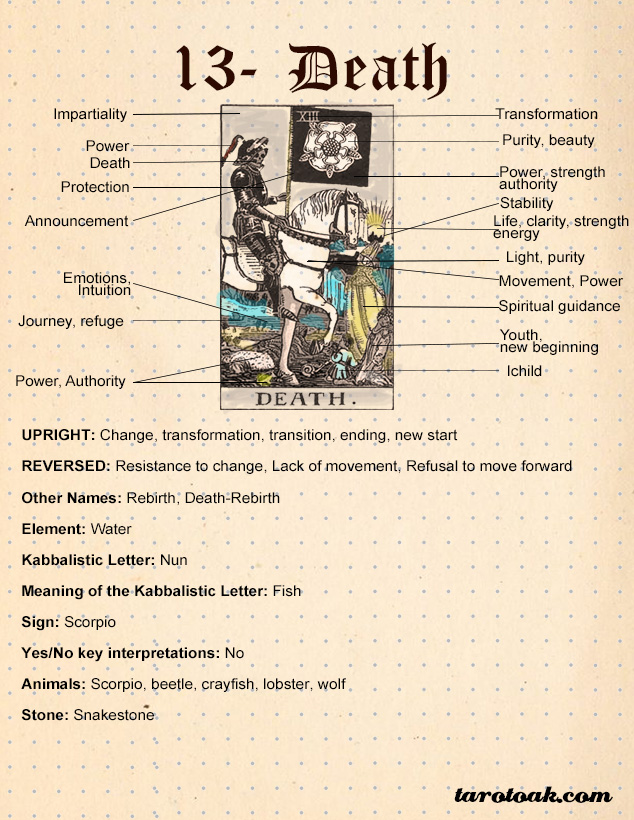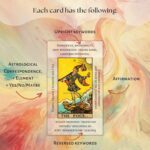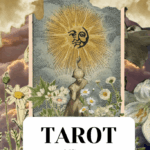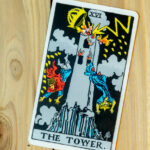The Death card in tarot, commonly depicted with a skeletal figure on horseback, often evokes immediate feelings of dread and trepidation. It appears at first glance an ominous harbinger of doom, but this interpretation is superficial at best. The complexities and nuances of the Death card offer an intriguing perspective on transformation and the cyclical nature of existence. Rather than a signifier of literal mortality, the Death card invites deeper contemplation and sheds light on the inevitability of change.
To comprehend the Death card’s meaning fully, one must consider the broader context of the tarot itself. Each card functions within a grander narrative, interweaving the tapestry of human experience. Many decks illustrate the Death card through various symbols such as a rising sun, wilting flowers, or even a phoenix, all of which converge to signify rebirth. This fusion of imagery leads practitioners and seekers alike to question; what truly dies when we draw this card?
One predominant interpretation of the Death card revolves around transformation. Much like the seasons that cyclically fade into one another, the card signifies not just an end, but the onset of something novel. This aligns closely with the natural order, as decay and demise often pave the way for renewal. When individuals confront substantial disruptions in their lives—be it the end of a relationship, the loss of a job, or the conclusion of a significant life phase—these occurrences, though painful, often ushers in profound personal growth.
Moreover, the Death card can symbolize the dismantling of outdated beliefs and practices. A common observation is that people tend to resist change, clinging to what is known, even if it is detrimental. In this sense, the card acts as a wake-up call, encouraging individuals to shed their fears and embrace the unknown. The fear of losing one’s identity or security often obstructs growth, yet the Death card beseeches you to confront these fears head-on.
Additionally, it is pivotal to understand the qualities associated with the card. Keywords often tied to the Death card include transformation, endings, and metamorphosis. The transformative quality is essential—think of the caterpillar that must first undergo the harrowing process of cocooning itself away before emerging glorious into the world as a butterfly. This metaphor encapsulates the essence of the Death card; it is about the trials necessary for evolution.
Equally, the Death card conveys messages about letting go. The act of relinquishing attachments is a recurring theme within psychology and spirituality. Letting go, whether of emotional baggage, toxic relationships, or even past regrets, can trigger an exhilarating renaissance of self. Thus, when this card appears in a reading, it invites an introspective audit of what should be dissolved to foster new beginnings. This prompt can elicit discomfort, yet it ultimately spurs healing.
Another layer of complexity belonging to the Death card is its connection to the unconscious. Within the realm of dreams and subconscious messages, death frequently emerges as a transformative symbol. Dreams portraying death often pursue themes of renewal or catharsis. They may reflect significant personal changes or indicate a latent desire to release entrenched patterns of behavior. The invocation of the Death card can likewise echo this subconscious interplay, nudging individuals toward introspection and self-discovery.
Moreover, the Death card’s implications are not exclusively personal; they can extend to larger social or spiritual realms. When applied metaphorically to societal structures, the card addresses the collapse and reconstruction of systems, ideologies, or relationships on a communal scale. Revolutions, social movements, and shifts in cultural paradigms often mirror the Death card’s essence, initiating necessary upheaval leading to reformation and rejuvenation.
It is equally worth noting that the Death card does not take a solitary position within the tarot; its influence is augmented depending on the other cards that accompany it in a reading. For example, the Death card drawn alongside the Tower card may suggest a more tumultuous transition characterized by chaos and upheaval, signifying the dismantling of the old. In contrast, when paired with cards such as the Star or the Sun, its implications may lean more towards positive endings and hopeful new horizons.
In summary, while the Death card may instill fear, its deeper meaning transcends the conventional lens of finality. It is an emblem of ultimate transformation, urging us to embrace cycles of endings and beginnings. The rich imagery and symbolism surrounding the card invite us to confront the uncomfortable facets of our existence—change, disruption, and the inevitable nature of loss—all in the context of renewal and evolution. This intricate interplay of narrative within the tarot beckons us to delve into the heart of our fears, prompting not just an exploration of mortality but also a profound understanding of life’s transient beauty.
Thus, the Death card stands not as a specter of desolation, but as a harbinger of hope and an invitation to embark on a journey of metamorphosis. As we navigate through life, the card invites us to recognize the vital importance of release, prompting an inquiry into what needs to die so that new life may flourish. Embracing this duality equips individuals with the tools to traverse the inevitable transformations of existence.










Leave a Comment